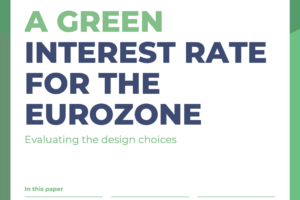REPORT: A Green Interest Rate for the Eurozone

In a new Policy Paper co-written with colleagues at Sustainable Finance Lab, we presents a proposal to advance Europe’s green transition: the introduction of a green interest rate by the European Central Bank (ECB). The proposal outlines how targeted monetary policy can play a crucial role in combating climate change, promoting sustainable investment, and supporting the ECB’s mandate of low and stable inflation.
Key points of the report:
- High interest rates slowing the green transition: Current monetary policy disproportionately affects renewable energy projects, which rely heavily on upfront investment. A green interest rate would eliminate this disadvantage and channel financing towards green projects.
- Tackling inflation by reducing dependency on fossil fuels: Europe’s reliance on oil and gas is a major driver of inflation. By encouraging investments in clean energy, the green interest rate could mitigate inflationary pressures caused by volatile fossil fuel prices, helping the ECB fulfill its price stability mandate.
- A significant challenge to implementing a green interest rate has been the definition of “green assets.” This paper proposes using the EU Taxonomy—a robust, politically legitimate EU framework for identifying sustainable activities—to guide the ECB in its green interest rate program.
- Recent progress on the implementation of the EU Taxonomy and related disclosure by banks significantly increase the political and practical feasibility of a green TLTRO. We analyse the various design choices that are available for policymakers to ensure a green rate would stimulate green lending, while being operationally feasible and not jeopardise the conduct of monetary policy.
- Based on the analysis of the Taxonomy alignment of 73 banks representing 80% of Eurozone banking assets, we further estimate that a green TLTRO could reach an annual size of between €317-378 billion. This order of magnitude is broadly in line with estimations of the green investment gap in Europe and falls within the possible envelope of the ECB’s future operational framework and liquidity management.
To cite this paper:
Jourdan, S., Van Tilburg, R., Kramer, B., Simić, A. and Bronstering, G. (2024) A green interest rate for the Eurozone: evaluating the design choices. Sustainable Finance Lab. Available at: https://sustainablefinancelab.nl/wp-content/uploads/sites/334/2024/09/A-green-interest-rate-for-Europe.pdf.